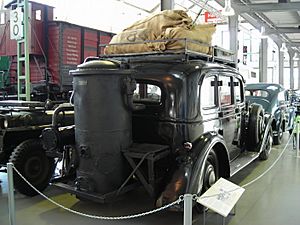Producer gas facts for kids
Producer gas is a special type of fuel gas. It is made by passing air and steam over very hot carbon, usually from a material called coke. Coke is what you get when coal is heated very strongly without any air. This process is called destructive distillation. Producer gas is a mix of different gases, mainly carbon monoxide, hydrogen, and nitrogen. It was once an important fuel for engines and industrial furnaces.
Contents
How Producer Gas is Made
Producer gas is made in a special device called a gas producer or gasifier. Imagine a tall, cylinder-shaped furnace. Inside, there's a bed of very hot coke or coal.
- Step 1: Heating the Fuel
First, the coke or coal is heated to very high temperatures, usually above 1,000 degrees Celsius (1,832 degrees Fahrenheit). This makes the carbon in the fuel glow red-hot.
- Step 2: Adding Air and Steam
Next, a controlled mix of air and steam (water vapor) is blown through the hot fuel bed.
- Step 3: Chemical Reactions
When the air and steam react with the hot carbon, several chemical changes happen: * The oxygen in the air reacts with carbon to form carbon monoxide (CO). This reaction also creates a lot of heat. * The steam (H₂O) reacts with carbon to form hydrogen (H₂) and more carbon monoxide (CO). This reaction actually uses up heat. * The nitrogen (N₂) from the air doesn't react and just passes through, becoming a big part of the final gas mix. The balance of these reactions helps keep the temperature right and produces the fuel gas.
What is Producer Gas Used For?
Producer gas was very important in the past, especially before natural gas became widely available.
- Industrial Furnaces
One of its main uses was to power industrial furnaces. These furnaces are used in factories to melt metals, make glass, or heat materials for different manufacturing processes. Because producer gas could be made on-site, it was a convenient and relatively cheap fuel for these large-scale operations.
- Engines
During times when other fuels were scarce, like during World War II, producer gas was also used to power internal combustion engines. Cars, trucks, and even buses were sometimes fitted with special gasifiers that would make producer gas from wood or charcoal. This allowed vehicles to run even when gasoline was hard to find.
- Early Power Generation
Some early power plants also used producer gas to run engines that generated electricity.
Why Producer Gas is Not Common Today
Today, producer gas is not used as much as it once was.
- Natural Gas and Other Fuels
Modern fuels like natural gas, propane, and electricity are often easier to use, cleaner, and more efficient. Natural gas, for example, can be piped directly to homes and factories, making it very convenient.
- Lower Energy Content
Producer gas has a lower energy content compared to natural gas. This means you need to burn more of it to get the same amount of heat or power. This is mainly because it contains a lot of nitrogen, which doesn't burn.
- Environmental Concerns
Making producer gas from coal can also create pollution. Modern technologies focus on cleaner energy sources and more efficient ways to use fuels.
However, the idea of gasification – turning solid fuels into gas – is still important. Scientists and engineers are looking at new ways to gasify biomass (like wood chips or agricultural waste) to create cleaner fuels or to capture carbon dioxide. This is part of the effort to find more sustainable energy solutions for the future.
Images for kids
See also
 In Spanish: Gas pobre para niños
In Spanish: Gas pobre para niños



